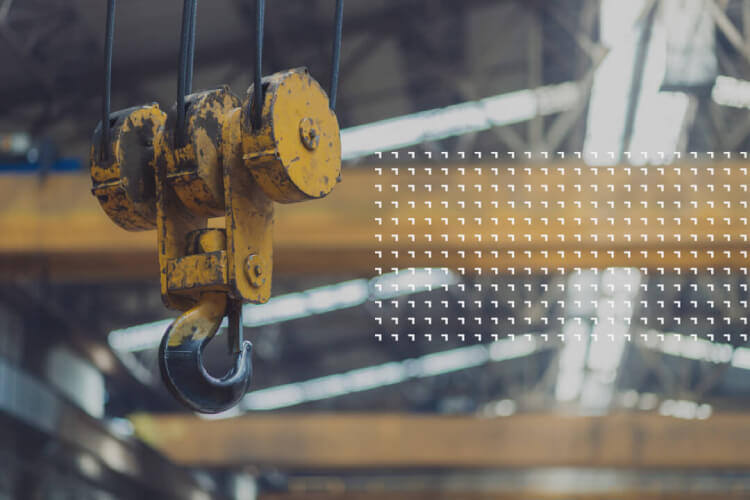
Safety is essential in any industrial setting. The stakes are high when overhead crane operations are involved. Poorly managed operations can result in avoidable equipment damage, plant shutdowns, and, worst of all, loss of life. If you work with or around overhead cranes, it's essential to understand overhead crane safety principles.
The Importance of Overhead Cranes
Overhead cranes play a crucial role in operations across many industries. From assembling rockets in aerospace hangers to getting the right construction materials to the right truck at a distribution center, these cranes enable the movement of heavy loads with precision and efficiency.
When managed effectively, these cranes have revolutionized material-handling processes that would've otherwise been too difficult or time-consuming to execute. The enhanced efficiency streamlines project schedules and paves the way for executing more intricate projects. A larger capacity overhead crane for a Ma & Pa shop can mean accepting bigger contracts.
Crane Safety by the Numbers
The complexity and power of cranes demand rigorous safety protocols to mitigate potential risks. The U.S. Bureau of Labor Statistics reported an average of 42 deaths involving cranes per year between 2011 and 2017. This annual average is an improvement from 78 yearly fatalities between 1992 and 2010, indicating the positive impact of the lifting industry's efforts in enhancing crane safety.
Many companies have created corporate safety policies, including regular training, to reduce the risks of working around overhead cranes. These policies follow leading industry standards from ASME and legal regulations from OSHA. However, some organizations using cranes are unfamiliar with these efforts or standards.
Running overhead crane operations without an awareness of safety increases the risk of:
- Fatalities
- Injuries
- Property damage
- Financial liabilities
- Regulatory penalties
- Lawsuits

Dr. Jim D. Wiethorn's research on crane accidents revealed that around 93% of crane accidents in the U.S. resulted from human error. A deeper dive into the accidents revealed that only 23.8% were due to the crane operator. The site supervisor, lift director, or owner was responsible for 37.4% of the accidents. "This highlights the importance of not only training your operators but training their leaders as well," says Larry Kime, senior instructor and inspector at CICB.
"We've all worked for supervisors and leadership who did not understand the process." Elaborates Trent Burns, another senior instructor and inspector at CICB. "This can make things more difficult for everyone."
OSHA Compliant Overhead Crane Operations
If something goes wrong, OSHA can investigate your operations to see what steps you took to establish a safe workplace. Although you often delegate tasks, you can't delegate your responsibility for safety. It's paramount to develop compliant operations to reduce the risks in the first place.
Cranes used for manufacturing fall under OSHA's 1910 general industry standards. However, overhead cranes used in construction and maritime have regulations specialized for those industries. Knowing what industry OSHA classifies your crane usage under is integral to establishing compliance.
Professionals working with overhead cranes must become familiar with the latest relevant ASME and CMAA standards. Different standards pertain to the various types of overhead crane systems. These standards lay out additional best practices and criteria for inspecting, operating, and maintaining overhead cranes.
OSHA only covers federal regulations. You may also need to follow local laws, company policies, and manufacturer processes.
Organizing for Success – Establish Your Team
Learning the roles and responsibilities of lifting is vital to organizing successful overhead crane operations. Although some personnel may share multiple responsibilities, knowing all the roles needed for a successful lift is essential. Missing a key role in a lifting team opens the door to disaster.
Key roles and responsibilities involved in overhead crane operations:
Management: Employers are responsible for creating a safe place of employment free from recognized hazards that can cause death or serious physical harm. To do this, they identify, document, and assign responsibilities to personnel involved in moving loads. They also provide safety training for their team members and ensure they meet the necessary criteria to perform their duties.
Lift Planner: The Lift Planner provides lift planning and oversight tailored to each hoisting operation. They do this to manage the varying conditions and their associated hazards sufficiently. Every lifting project requires an adequate level of lift planning before ensuring personnel know what is going to happen.
Crane Operators: They operate the crane following applicable laws, standards, manufacturer specifications, and employer procedures. Employers must verify that operators meet the applicable training criteria before operating.
Rigger: Riggers ensure the handling, hardware, inspection, and configuration of rigging assemblies meet the applicable requirements. Riggers also need to be trained or demonstrate experience to perform their role.
Signalperson: A signalperson communicates with the crane operator in applications where the operator cannot see the load.
Inspector: Overhead cranes require daily, monthly, and annual inspections, often completed by different personnel. Crane operators using the crane daily typically conduct the shift and monthly inspections. Companies generally opt for a second or third-party inspector for annual inspections.
Once you know the roles involved in lifting loads, learning how they work together is essential. Not every company will have designated personnel for each role, so employees often wear multiple hats. Once you know the roles of an ideal structure, you can see gaps where certain personnel may need additional training to cover essential tasks.

Common Organizational Structure
You will have designated personnel for each lifting role in the ideal situation. There will even be a safety manager who focuses on establishing and maintaining compliance.

Combined Roles
Employers still need to ensure these functions are fulfilled even when employees aren't designated to each responsibility. It's important to fill the gaps by cross-training existing employees. Lift planning is a commonly overlooked responsibility best executed by a manager or supervisor with ample knowledge of safe crane operating and rigging. This is because planning lifts requires knowledge of all the systems and equipment used and their capacities.
Even though a signalperson isn't always needed, it doesn't hurt to have rigging personnel trained on signaling, just in case. It's good practice to train overhead crane operators on inspection procedures so they can conduct the necessary shift and monthly inspections before using the crane.

Scaled Down Structure
There are cases where there is just a designated supervisor and overhead crane operator. When there is no rigger, we recommend that the operator be thoroughly trained in rigging. The fewer personnel, the easier it is to overlook essential roles like rigging, especially in bare-bones operations. Make sure this role isn't overlooked because poor rigging can easily cause loads to fail, resulting in damaged goods and lost production time.
4 Tips for Safe Overhead Crane Operating Procedures:
- Learn Where You Are: The first step to improved safety is learning where you are and how processes can improve. You can do this by having an internal or external subject matter expert conduct a compliance evaluation. This first step can save you from investing in the wrong path to improved safety.
- Conduct Regular Inspections: There are legal requirements for regularly inspecting overhead cranes. This practice also helps ensure the equipment is in good working condition, reducing wear and tear and the risk of operational failure. Make sure you are following the proper crane inspection practices.
- Understand Capacity: Overloading is a leading cause of crane accidents. Understanding the capacity limitations of your overhead crane and rigging set by the manufacturer is essential. Exceeding these limits will strain the equipment's structural integrity, compromising the equipment and the safety of everyone around.
- Comprehensive Training: Inefficient operations, accidents, and legal liabilities are more expensive than adequate training. Since employers are responsible for establishing safety and validating their employees' expertise, regular documented training is one of the best ways to maintain overhead crane operating safety and compliance.
Take Your Overhead Crane Operations to the Next Level
CICB offers compliance evaluations and comprehensive training for overhead crane operators, inspectors, riggers, and supervisors to help you establish compliant, efficient, and safe lifting operations. Contact us for a training consultation.
About The Author
 Larry Kime brings over two decades of experience to CICB, serving as a Senior Instructor/Inspector and Technical Advisor. A U.S. Air Force veteran, Larry has dedicated his career to promoting safety and compliance in the lifting industry. Known for his engaging teaching style and deep technical expertise, he is highly regarded by professionals across the field. Larry’s commitment to continuous learning and mentorship makes him a valued member of the CICB team.
Larry Kime brings over two decades of experience to CICB, serving as a Senior Instructor/Inspector and Technical Advisor. A U.S. Air Force veteran, Larry has dedicated his career to promoting safety and compliance in the lifting industry. Known for his engaging teaching style and deep technical expertise, he is highly regarded by professionals across the field. Larry’s commitment to continuous learning and mentorship makes him a valued member of the CICB team.





